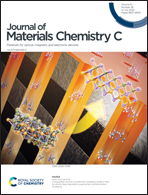Aluminum chloride assisted synthesis of near-unity emitting Mn2+-doped CsPbCl3 perovskite nanocrystals for bright white light-emitting diodes†
Abstract
Mn2+ doped perovskite nanocrystals (NCs) have important applications in the field of white light-emitting diodes (WLEDs) due to their bright orange-red luminescence and large Stokes shift. However, the development of orange-red Mn2+ emission in doped perovskite NCs is still far behind performance in comparison with its undoped counterparts. Herein, we report an environment-friendly strategy of AlCl3-assisted Mn2+ doped CsPbCl3 NCs through a hot injection method for obtaining high-quality WLEDs. By adding AlCl3 as a precursor, the synthesized Mn2+ doped CsPbCl3 NCs show a bright orange-red emission peaked at about 600 nm, with a high photoluminescence quantum yield (PL QY) of up to 87%. It is found that the introduction of strong Lewis acid AlCl3 in the process of NC synthesis effectively improves the doping efficiency of Mn2+ ions and enhances the energy transfer from host excitons to Mn2+ ions. Meanwhile, the self-passivation aluminum hydroxide and alumina layer after AlCl3 hydrolysis make NCs form a core/shell structure which effectively passivates the defects on the surface of NCs. The as-prepared Mn2+ doped CsPbCl3 NCs are further coated with silica, and the dense double-layer protective shell further passivates the defects of the NCs and inhibits the non-radiative recombination, so that the PL QY of Mn2+ doped CsPbCl3 NCs reaches up to 98%. For application demonstration, a WLED is manufactured by using the as-prepared orange-red NCs, which exhibit bright white light emission with chromaticity coordinates of (0.337, 0.320) and a high color-rendering index of 95, demonstrating its broad future applications in solid-state lighting and display fields.



 Please wait while we load your content...
Please wait while we load your content...